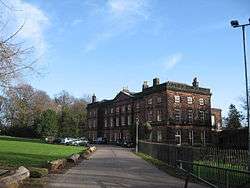Allerton Hall
Allerton Hall is in Clarke's Gardens, Allerton, Liverpool, Merseyside, England. It is recorded in the National Heritage List for England as a designated Grade II* listed building.[1]
| Allerton Hall | |
|---|---|
 Allerton Hall | |
| Location | Clarke's Gardens, Allerton, Liverpool, Merseyside, England |
| Coordinates | 53.3634°N 2.8791°W |
| OS grid reference | SJ 415 855 |
| Built | c. 1736 |
| Built for | John Hardman, William Roscoe |
| Architectural style(s) | Palladian |
Listed Building – Grade II* | |
| Designated | 14 March 1975 |
| Reference no. | 1063751 |
 Location in Merseyside | |
History
During the medieval period the manor of Allerton was held by the Lathom family.[2]
During her long widowhood, Elizabeth Lathom (née Legh), the wife of Richard Lathom (1563–1602), occupied Allerton Hall. And by her Will and Codicil, both executed in July, 1624, gave her second son, Edward Lathom, the occupation and profit of “this my hall in Allerton," and the houses and lands for three years after her death for the better discharging of her debts and to keep her other sons, Richard and John, “with dyet." and until her grandson, Richard Lathom (of Parbold, son of Thomas who died in 1623), then an infant of about two years old, the heir of Parbold and Allerton, "came of age".
Richard Lathom, a Royalist, fought alongside his uncles in the English Civil War. Richard survived the war but his Estate was "forfeited in the name of treason" by Cromwell's parliament in 1652.
"The commissioners" (of parliament who had confiscated the estate) sold it in 1654 to a John Sumpner of Midhurst, Sussex. for £2,700. Notwithstanding that the Lathoms, father, mother, and children, now dispossessed, were frequently convicted of recusancy and suffered the penalties accordingly, they contrived to hang on to both Parbold and Allerton a little longer. Indeed, it was not until 1670 that the Sumpners managed to eject the Lathoms, and only then by increasing the amount of the original purchase price.
When assessments were made for the hearth tax in 1666, Allerton Hall was one of the larger houses in the parish of Childwall with eight hearths; this was exceeded only by Speke Hall with twenty-one hearths and Brettargh Holt with nine.[3] The estate was bought in 1736 by John Hardman and his brother James, and it is likely that the present house on the site originates from this time. John Hardman was a West Indies merchant originally from Rochdale.[2] Sold to the Hardmans in 1736 for £7,700 and rebuilt in the Palladian style. The Hardmans were involved in c 46 slave voyages between 1729 and 1761.
The property passed to James Hardman's widow, Jane, in 1754.[4] In about 1779, the house was bought by the lawyer, philanthropist and abolitionist, William Roscoe.[5] Roscoe completed the building of the house but had to sell it in 1816 when he became bankrupt.[2]
During the American Civil War, the mansion was rented by Charles Kuhn Prioleau, an American landowner from South Carolina who financially supported the Confederate States and who married Mary Elizabeth Wright, daughter of the owner of the hall.[6] In the early part of the 20th century the building was owned by the Clarke family who donated it to Liverpool City Council in 1927.[7] The building was damaged by two fires, in 1994 and in 1995.[2]
Architecture
Allerton Hall is designed in Palladian style and built in red sandstone with three storeys.[2] It is a symmetrical building, extending over eleven bays; the central three bays and the lateral two bays on each side project forward.[1] The central three bays form a portico with Ionic columns and a pediment. The ground floor of the building is rusticated.[2]
Surviving the fires, are a room at the west end which has panelled walls and a stucco ceiling in Rococo style, and parts of Roscoe's library. In the grounds to the west of the house is a sundial dated 1750.[2]
Present day
In 2009 Allerton Hall was run as a public house known as the Pub in the Park. As of 2017, it is known as Allerton Hall - Farmhouse Inn.[8]
References
- Historic England (2011), "Allerton Hall (1063751)", National Heritage List for England, retrieved 8 May 2011
- Pollard, Richard; Pevsner, Nikolaus (2006), Lancashire: Liverpool and the South-West, The Buildings of England, New Haven and London: Yale University Press, p. 392, ISBN 0-300-10910-5
- Farrer, William; Brownbill, J. (eds.) (1907), The parish of Childwall: Introduction, church and charities, Victoria County History: A History of the County of Lancaster, 3, pp. 102–108, retrieved 1 October 2009CS1 maint: extra text: authors list (link)
- Jane Hardman, Lancashire Museums
- Liverpool Century by Century, Liverpool History Online Project, archived from the original on 16 January 2009, retrieved 1 October 2009
- Allerton Hall, Merseyside, The DiCamillo Companion, archived from the original on 19 May 2011, retrieved 1 October 2009
- Sandstone: Allerton Hall, allertonOak, archived from the original on 9 April 2009, retrieved 1 October 2009
- Allerton Hall (the pub in the park), Pub-Explorer.com, archived from the original on 22 August 2009, retrieved 28 September 2009